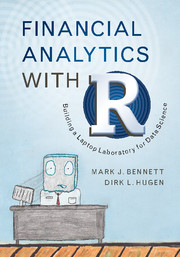Book contents
- Frontmatter
- Dedication
- Contents
- Preface
- Acknowledgments
- 1 Analytical Thinking
- 2 The R Language for Statistical Computing
- 3 Financial Statistics
- 4 Financial Securities
- 5 Dataset Analytics and Risk Measurement
- 6 Time Series Analysis
- 7 The Sharpe Ratio
- 8 Markowitz Mean-Variance Optimization
- 9 Cluster Analysis
- 10 Gauging the Market Sentiment
- 11 Simulating Trading Strategies
- 12 Data Exploration Using Fundamentals
- 13 Prediction Using Fundamentals
- 14 Binomial Model for Options
- 15 Black–Scholes Model and Option-Implied Volatility
- Appendix Probability Distributions and Statistical Analysis
- References
- Index
10 - Gauging the Market Sentiment
Published online by Cambridge University Press: 20 October 2016
- Frontmatter
- Dedication
- Contents
- Preface
- Acknowledgments
- 1 Analytical Thinking
- 2 The R Language for Statistical Computing
- 3 Financial Statistics
- 4 Financial Securities
- 5 Dataset Analytics and Risk Measurement
- 6 Time Series Analysis
- 7 The Sharpe Ratio
- 8 Markowitz Mean-Variance Optimization
- 9 Cluster Analysis
- 10 Gauging the Market Sentiment
- 11 Simulating Trading Strategies
- 12 Data Exploration Using Fundamentals
- 13 Prediction Using Fundamentals
- 14 Binomial Model for Options
- 15 Black–Scholes Model and Option-Implied Volatility
- Appendix Probability Distributions and Statistical Analysis
- References
- Index
Summary
The most common market regimes are the bull and bear regime. In Chapter 9 we discussed how to use the undirected Gaussian Graphical Model to gauge the market sentiment on a portfolio basis. Specifically the amount of sparsity – the number of absent edges in the graph – was an indication of the bullishness of the current market, to a degree.
Often it is hard to tell which regime the market is in. If this was easy to do, following a bullish or bearish trend would certainly be accomplished more frequently than it is currently. The time window of observation helps to determine the regime. Many market practitioners note that volatility is typically lower in a bull market than in a bear market. The panic that can set in during a crisis, which often are present in many bear markets, causes prices to fall faster than they typically rise. Sometimes this difference can be very pronounced, as those of us who experienced the 2000–1 and 2008–9 market drops know well.
Tools for determining market sentiment have a long history. This chapter begins with an application of a theory for market regime switching (Ang and Bekaert, 2004). The approach was introduced by Ang and Bekaert in the 2004 paper, “How regimes affect asset allocation.” We proceed along the following lines. First, we load in raw prices and calculate the returns of our risky assets, in our case here the S&P 500 (SPY), the Swiss index (EWL), and the Japanese index (EWJ). These three assets roughly correspond to the geographic areas Ang and Bekaert found to be most important in international diversification. The economic rationale behind Ang and Bekaert's findings is that consumers are more able to delay purchases of durable goods (which tend to be produced in advanced manufacturing economies) and less able to delay purchases of service goods. For example, if I don't have a job, then I can delay the purchase of a new car, but I cannot delay paying my phone bill or my rent. Along this line of thinking, the ability to delay on the part of consumers leads manufacturing economies to show disproportionately poor returns during economic downturns. This in turn opens up an arbitrage opportunity.
- Type
- Chapter
- Information
- Financial Analytics with RBuilding a Laptop Laboratory for Data Science, pp. 240 - 260Publisher: Cambridge University PressPrint publication year: 2016



